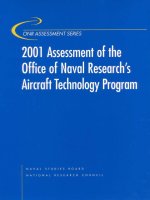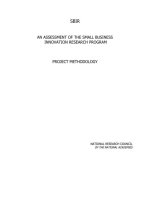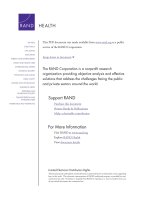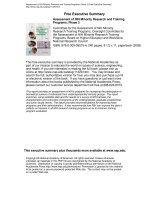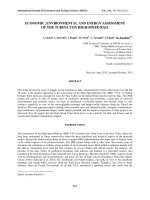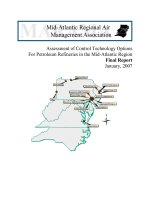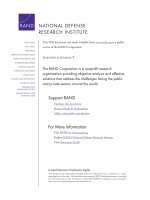Pathomorphological assessment of sub-acute dermal toxicity of Morinda citrifolia Linn. Fruit extract coated gold nano particles in wistar rats
Bạn đang xem bản rút gọn của tài liệu. Xem và tải ngay bản đầy đủ của tài liệu tại đây (725.45 KB, 16 trang )
Int.J.Curr.Microbiol.App.Sci (2019) 8(9): 1160-1175
International Journal of Current Microbiology and Applied Sciences
ISSN: 2319-7706 Volume 8 Number 09 (2019)
Journal homepage:
Original Research Article
/>
Pathomorphological Assessment of Sub-Acute Dermal Toxicity of
Morinda citrifolia Linn. Fruit Extract Coated Gold Nano Particles
in Wistar Rats
A. R. Pawar1, S. R. Rajurkar1, N. D. Jadhav1*, G. R. Gangane2 and S. Bhalchim2
1
Department of Veterinary Pharmacology and Toxicology, India
2
Department of Veterinary Pathology, India
College of Veterinary and Animal Sciences, Parbhani 431402, India
Maharashtra Animal and Fishery Sciences, University, Nagpur, India
*Corresponding author
ABSTRACT
Keywords
Sub-acute dermal
toxicity, Morinda
citrifolia,
Pathomorphology in
dermal toxicity,
Gold Nano
particles.
Article Info
Accepted:
18 August 2019
Available Online:
10 September 2019
Gold nanoparticles (GNPs) an emerging part of nanomedicine holds great promise for
revolutionizing medical treatments and therapies in areas such as imaging, drug
delivery, faster diagnosis, and tissue regeneration, as well as the development of new
medical products. But their safety assessment is a major concern. As body system
reacts in a different way than isolated cell line than artificial environment, so in the
present experiment pathomorphological assessment ofsub-acute dermal toxicity of
green synthesized GNPs and coating with Morinda citrifolia fruit extract (McFE) was
undertaken. Gold nanoparticles were synthesized by biological reduction of
chloroauric acid with Azadirachta indica (neem) 5% leaf extract. The nanoparticles
characterized and were confirmed by colour changes from pale yellow to ruby red.
These nanoparticles were coated with McFE.For toxicity evaluation.50 Wistar rats of
either sex were assigned to five groups. One group was considered healthy, three
groups received dermal application of combination of 1 mg/kg GNPs with 150mg/kg
McFE (Low dose), 2mg/kg GNPs with 300mg/kg McFE (Medium dose) and 4 mg/kg
GNPs with 600mg/kg McFE (High dose) dermal application for 28 days. The last
group was considered as satellite group which received 8 mg/kg GNPs with 1200
mg/kg McFE and observed for extra 14 day beyond trial period for checking post
withdrawal effect. Grossly mild hemorrhages, congestion and architectural alteration
were observed in liver and kidney treated with highest dose. However the
histopathological examination of skin revealed no alteration in skin architecture but
minimal alterations were observed in liver and kidney where major changes like
dilatation of central vein and sinusoidal space, multifocal necrobiotic changes and
focal fatty change in liver and cystic degeneration and hyaline cast in lumen of kidney
noticed indicating proper absorption and excretion of GNPs from body.
1160
Int.J.Curr.Microbiol.App.Sci (2019) 8(9): 1160-1175
Introduction
Nanoparticles has multifunctional properties
and very interesting applications in various
fields such as medicine, nutrition, and energy1.
From as early as 2500 BC, the therapeutic
benefits of gold preparations have been
reported in Indian, Arabic, and Chinese
literature2. Swarna (gold) bhasma has been
utilized as a therapeutic indian ayurvedic
medicine for several clinical disorders
including bronchial asthma, rheumatoid
arthritis, diabetes mellitus3. Nano-medicine is
widely seen as having huge potential to bring
profits to many areas of research and
applications and it can be uses to maintain,
monitor, treat, and prevent diseases. Gold
nanoparticles have a wide scope of
applications in molecular biology and
biomedicine, which includes cell/biomedical
imaging, biosensing, peptide delivery and
drug delivery4.
Gold nanoparticles (AuNPs), an emerging
nano-medicine is renowned for its promising
therapeutic possibilities, due to its significant
properties such as biocompatibility, high
surface reactivity, resistance to oxidation and
surface
plasmon
resonance5.Gold
nanoparticles are compatible for a wide range
of biological applications, because of their
unique physical and chemical properties.
Recently,
the
applications
of
gold
nanoparticles have expanded into various
biomedical fields (biosensors, immunoassays,
genomics, photo thermolysis of cancer cells,
microorganisms detection and control,
targeted drug delivery, optical imaging,
monitoring of biological cells and tissues by
exploiting resonance scattering, or in vivo
photo acoustic techniques6. The role of gold
nanoparticles invading the treatment for
various inflammatory diseases, other relative
disorders and in modern medicine, gold
nanoparticles find significant applications in
drug delivery system as they are capable of
encapsulating active drugs and targeting7.Gold
NPs have very unique physicochemical
properties
and
capability
of
easy
functionalization, binding to amine and thiol
groups. All these characteristics possessed by
gold NPs pave the way for surface
modification and are being investigated as
drug carriers in cancer and thermal therapy
and as contrast agent.
Morinda citrifolia belongs to family
Rubiacea8.Indian mulberry (Noni) is a small to
medium sized evergreen tree that is widely
distributed in the tropics. The leaves are 8-10
inches long, oval shaped; dark green and shiny
with deep veins9.
Noni is largely used in traditional medicine
and has wide range of uses; including arthritis,
atherosclerosis, boils, burns, cancer, chronic
fatigue syndrome, circulatory weakness, cold
sores, congestion, constipation, diabetes,
gastric ulcers, gingivitis, heart disease,
hypertension and infections10. Several reports
have described various potential health
benefits of M. citrifolia fruit including
immune modulation and antioxidant activities
in vitro and in vivo11 and in vivo antihyperlipidemic effect12. Since the efficacy
ofMorinda citrifolia Linn. as an antidiabetic
and antihypertensive, antioxidant, antihyperlipidemic and AuNPs as potent drug
delivery system are proved, the investigations
on the efficacy of gold nano particle alone and
Morinda citrifolia Linn. coated gold nano
particles is studied in the department of
Veterinary Pharmacology & Toxicology,
College of Veterinary & Animal Sciences,
Parbhani, it is necessary to study the adverse
or toxic effects if any of the same.
Morinda citrifolia Linn fruit extract contains
the anti-inflammatory activity when given
internally well as when applied locally, thus
the extract is expected to be applied over skin
and looking to this the safety evaluation of the
1161
Int.J.Curr.Microbiol.App.Sci (2019) 8(9): 1160-1175
plant and extract coated gold nanoparticles is
essential.Morinda citrifolia Linn. fruit extract
possess antitumor activity and hence its local
application is also expected. Morinda citrifolia
Linn fruit extract coated gold nanoparticles are
also expected to be given through skin as an
external application. It is necessary to evaluate
the same for its dermal toxicity.
Department of Veterinary Pharmacology &
Toxicology, COVAS, Parbhani since last 5
years is working on synthesis of metal
nanoparticles, its coating with herbal extracts
and efficacy studies of the same. To draw a
fruitful recommendation on the use of
Morinda citrifolia Linn coated gold nano
particles it is necessary to investigate its toxic
effects. Hence, present study is proposed to
investigate possible health hazards likely to
arise from repeated dermal exposure over 28
days13.
Materials and Methods
The present investigation was carried out on
50 wistar rats in small animal laboratory
house,
Department
of
Veterinary
Pharmacology and Toxicology, College of
Veterinary and Animal Sciences, Parbhani,
MAFSU, Maharashtra.
Experimental animals
Experimental animals (Wistar rats) were
purchased from Sanzyme,Ltd. Hyderabad. The
present study was conducted on 50 Wistar rats
of either sex. The animals were selected to be
within a weight range 200-250 g for each sex
and age ranges from 8-10 weeks. Wistar rats
were housed in small animal lab house room
no.3 in standard laboratory conditions,
provided with ad-libitum food and water. The
Institutional Animals Ethical Committee
(IAEC) approved the experimental protocol
vide Resolution no. IAEC/09/17 dated
18/02/2017. All necessary managemental
procedures were adopted to keep the animals
free from stress.
Husbandry
Housing
Temperature
Relative Humidity
Photoperiod
light
Light intensity
Food
Water
: Cage system
: 22±3oC
: 30-70%
: 12 hr dark & 12 hr
: 130- 140 Lux
: Pelleted diet
: Clean purified water
Acclimatization,
grouping
identification of experimental animals
and
Wistar rats were acclimatized to experimental
room condition for five days. After
acclimatization to the experimental conditions
all the 50 Wistar rats were randomly divided
into five groups, each containing 10 rats of
either sex. All the animals were maintained for
the experimental period of 28 days except the
satellite group, which was maintained for 14
more days but without any treatment, only
under
observation
for
reversibility,
persistence, or delayed occurrence of toxic
effects or to study the post withdrawal effect
with highest dose given. Wistar rats were kept
individually in separate cages, each cage were
identified with a label, cage no, group details,
treatment type and marking were specific to
identify the animals.
Drugs and chemicals
Gold chloride
Gold chloride was used to produce gold
nanoparticles (GNPs) by biological reduction
method by using Azadirachta indica (neem)
leaf extract.
Compound name : Chloroauric acid Extra Pure ACS
Chemical name : Tetrachloroauric (III) acid trihydrate
Moecular.weight. : 339.79 (anhydrous basis)
1162
Int.J.Curr.Microbiol.App.Sci (2019) 8(9): 1160-1175
Product code
Molecular formula
Batch No.
Company
LTD,
Physical appearance
Storage condition
Vehicle
: 0273400001
: HAuCl4.3H2O
:L223221703
: LOBA CHEMIE PVT.
MUMBAI
:Yellow colored powder
: 0 –40 C
: Deionised water
The weight of empty glass plates were noted
and final weight after drying was obtained.
Resulting extracts were scraped off the glass
plate and stored in a container at 40C for
dosing of rats during experiment.
Preparation of site for drug application
Morinda citrifolia (Noni)
Botanical name
: Morinda citrifolia
Family
: Rubiaceae (coffee
family)
Common name
: Indian mulberry,
beach mulberry,
great morinda
English
: Noni
Hindi
: Bartundi
Sanskrit
: Ayushka
Marathi
: Nagakunda
Gujarati
: Surangi
Morinda citrifolia (Noni) fruits extract
Aqueous extract of Morinda citrifolia L. fruit
was prepared by cold extraction method. Noni
fruits were procured from the College of Food
Science
and
Technology,
VNMKV,
Parbhani(Fig no-3).They were cut into pieces
and allowed to dry completely under shade.
Dried fruit pieces were ground to powder with
the help of an electric grinder.
Then, 20% aqueous solution was made by
dissolving 200 grams of powder in double
distilled water and the final quantity was made
to 1 liter. It was mixed thoroughly and
allowed to soak for 48 hours at 40C in
refrigerator with intermittent shaking using an
electrically operated flask shaker.
Thus, resulting solutions was first filtered by
using muslin cloth and then by filter paper in
to glass plates. They were allowed to dry
under shade and hence aqueous extract of
Morinda citrifolia was obtained.
Fur of all the experimental animals was
clipped from dorsal area of the trunk under the
inhalation anesthesia (di-ethyl ether) using an
electric clipper, followed by manual shaving
using razor blade.
Based on OECD guideline 410, not less than
10% of the body surface area was cleared for
the application of the test substance. The
dorsal area was applied with the Morinda
citrifolia Linn. fruit extract coated GNPs.
Animals were applied with the test substance
for 6 hours per day on a 7-day per week basis,
for a period of 28 days (Figure 2).
Experimental design
Table 1 shows experimental design,
distribution of different groups and treatment
given. Group –I is taken as healthy control.
Group –II, III and IV are treated with different
doses of Morinda citrifolia coated GNPs.
Group –V is taken as satellite group with
highest dose of Morinda citrifolia coated
GNPs. Each group contains 10 animals of
either sex.
Organ weight
The absolute organ weights of liver, kidney
and heart were noted in control and post
treatment sacrificed Wistar rats.
Pathological observations
All the rats in each group were sacrificed on
the termination of the experiment and the
1163
Int.J.Curr.Microbiol.App.Sci (2019) 8(9): 1160-1175
organs were subjected to the gross and
microscopic examinations.
Gross pathology
The organs in experimental sacrificed Wistar
rats were observed for the presence of any
abnormal gross pathological change.
Histopathological changes
Liver, kidney and skin tissue were collected in
10 percent formalin and were dehydrated in
ascending grade of alcohol, cleared in xylene
and embedded in paraffin wax. Four to five
micron thick sections were stained with
routine Haematoxylin and Eosin-staining
method and examined14.
Statistical analysis
The data obtained from various parameters
from all the groups was analyzed by as per
method suggested by using factorial
randomized block design (FRBD) and
completely randomized block design (CRD)
as per requirement and interpreted15.
Results and Discussion
Morinda citrifolia fruit extract preparation
For the preparation of Morinda citrifolia fruit
extract 8.500 kg fresh fruit was collected.
After shade drying and maceration, 3.200 kg
fruit powder was obtained. Hence by this
procedure dry matter % was found to be
37.64%. all the powder was processed for
extract preparation and 143 g aqueous extract
was obtained. Percent extractability by this
method was found to be 4.46%.
Synthesis, coating and characterization
GNPs
Synthesis of gold nanoparticles was confirmed
by color change, which was very well visible
to naked eye. When 9ml of 1mM chloroauric
acid solution (faint yellow) was reacted with
1ml of 5% extract of Azadirachta indica
(neem) leaves (also faint yellow colour),
immediately colour change was observed.
After 30 minutes of incubation, solution
turned to ruby red to violet colour. When the
tubes were left for 2 hours of incubation the
colour intensified and tuned to reddish-black
colour. To confirm this colour change was due
to the formation of gold nanoparticles, one
chloroauric acid control (1mM, 10ml) and
another extract control (9ml distilled water +
1ml 5% Azadirachta indica leaf extract) was
maintained. The colour change was compared
to them as shown in (Figure 1).
Gross examination
The gross pathological examination was
carried out at the end of the experimental
period in sacrificed rats of all experimental
groups. The gross examination revealed mild
degree
of
affections
like
petechial
hemorrhages, slight congestion seen in
treatment groups. Similarly congestion of mild
to moderate degree along with multifocal
hemorrhages was seen in kidney of high doses
group. Skin did not reveal any appreciable
gross pathological changes in any of the
treatment groups as shown in (Figure 4).
Relative Organ Weights
Mean organ weights in grams of liver, kidney
and heart in different groups were recorded
after gross pathological examination. The
details are given in Table-2.
The absolute organ weights of Liver, Kidneys
and Heart of all the experimental rats were
taken at the end of study period. The absolute
organ weights of Liver, Kidneys and Heart
were ranged between 6.65±0.36 to 8.45±0.71,
1.78±0.12 to 2.24±0.11 and 0.91±0.06 to
1.21±0.08 respectively. These values did not
1164
Int.J.Curr.Microbiol.App.Sci (2019) 8(9): 1160-1175
showed significant variations except the mean
values of heart weight in the rats of group
found to be increased significantly as compare
to respective healthy control group indicating
minimal toxicity induction.
Superscripts a,b,c,d,e shows significant
difference within the column (between
different groups on specific day) (p = 0.05).
Superscripts p,q,r shows significant difference
within the row (between different days in
specific groups) (p = 0.05)
Histopathological alterations
The histopathological alterations found in
liver, kidney and skin of rats of healthy
control and Morrinda citrifolia fruit extract
coated GNPs treated groups are described as
follows.
Liver
Liver from the experimental rats of Morinda
citrifolia fruit extract coated GNPs dose III
(group- IV).
On its histoarchitectural studies revealed
congestion, focal mononuclear cell infiltration
and degenerative changes (H & E Stain,
X400)as shown in (Figure 5). Multifocal fatty
change and mononuclear cell infiltration in
parenchyma of liver (H&E Stain, X400)as
shown in (Figure 6).Liver with moderate
cytoplasmic rarefication and occasional fatty
change (H & E Stain, X400) as shown in
(Figure 7).
Also, the liver of experimental rats of group
Morinda citrifolia fruit extractcoated GNPs
dose I & II (group II & III) when subjected for
histopathology noted minimal congestion &
focal mononuclear cell infiltration. The
histopathological alterations observedare in
close approximation with the present
findings16-19.
Kidney
The histopathological examination of kidneys
from experimental rats of Morinda citrifolia
fruit extract coated GNPs dose III (group IV)
revealedcongestion and mononuclear cell
infiltration in Kidney (H &E Stain, X400)
asshown in (Figure 8), multifocal cystic,
vacuolar
degenerative
changes
and
mononuclear cell infiltration in Kidney (H &
E Stain, X100) as shown in (Figure 9).Section
of a Kidney with vacuolar degenerative
changes,
necrobiotic
changes
and
mononuclear cell infiltration (H & E Stain,
X400)as shown in (Figure 10), focal hyaline
cast in lumen of proximal convoluted tubules
and necrobiotic changes in affected tubules (H
& E Stain, X400) as shown in(Figure
11).However the sections of kidneys of
Morinda citrifolia fruit extract coated GNPs
dose I & II (group II & III) revealed mild
congestion and mononuclear cell infiltration
with occasional degenerative changes. These
histopathological changes are also reported by
several workers17-19.
Skin
The histopathological studies of all
experimental rats did not show any
appreciable change in any of the skin section
examined. A section of skin with normal
histoarchitecture (H & E Stain, X100) as
shown in (Figure 12) and (H & E Stain, X400)
as shown in (Figure 13). The similar changes
reported by zahi20.
1165
Int.J.Curr.Microbiol.App.Sci (2019) 8(9): 1160-1175
Fig.1 Confirmation of Gold nanoparticles formed by observing colour change through naked eye
A . Natural colour of 1mM solution of chloroauric acid
B. Natural colour of 5% aqueous leaf extracts of Azadirachta indica(Neem) Plant
C. Ruby red color formed after addition of 1mM solution of chloroauricacid and 5% aqueous leaf extracts of
Azadirachta indica (Neem) Plantand 0.5 hour of incubation
D. Ruby red color darkens to reddish black after addition of 1mM solutionof chloroauric acid and 5% aqueous leaf
extracts of Azadirachta indica (Neem) Plant and 2 hour of incubation
Fig.2 Preparation of site for dermal application of
drug
1166
Fig.3 Morinda citrifolia(noni)fruit
Int.J.Curr.Microbiol.App.Sci (2019) 8(9): 1160-1175
Fig.4 Gross examination of organs at the time of sacrifice
1.Liver 2.Kidney 3.Heart
A) Healthy Control, B) Highest dose of coated GNPs
1.(A)
1.(B)
2.(A)
2.(B)
3(A) 3(B)
1167
Int.J.Curr.Microbiol.App.Sci (2019) 8(9): 1160-1175
Fig.5 Section of Liver with congestion, focal MNC infiltration and
degenerative changes (H & E Stain, X400)
Fig.6 Note Multifocal fatty change and MNC infiltration in parenchyma of liver (H&E Stain, X400)
Fig.7 Liver with moderate cytoplasmic rarefication and occasional fatty change (H & E Stain, X400)
1168
Int.J.Curr.Microbiol.App.Sci (2019) 8(9): 1160-1175
Fig. 8 Note congestion and MNC infiltration in Kidney (H &E Stain, X400)
Fig. 9 Note multifocal cystic, vacuolar degenerative changes and MNC infiltration in Kidney (H
& E Stain, X100)
Fig.10 Section of a Kidney with vacuolar degenerative changes, necrobiotic changes and MNC
infiltration (H & E Stain, X400)
1169
Int.J.Curr.Microbiol.App.Sci (2019) 8(9): 1160-1175
Fig.11 Focal hyaline cast in lumen of PCT and necobiotic changes in affected tubules (H & E
Stain, X400)
Fig.12 A section of skin with normal histoarchitecture (H & E Stain, X100)
Fig.13 A section of skin with normal histoarchitecture (H & E Stain, X400)
1170
Int.J.Curr.Microbiol.App.Sci (2019) 8(9): 1160-1175
Table.1 Experimental design
Group
Name of Group
Treatment
Dose
Route
I
Healthy control
Deionised water
1 ml
Dermal
II
Morinda citrifolia fruit
extract Coated GNP
Dose –I
Gold nanoparticles
@ 1 mg/kg Bwt.
Dermal
Morinda citrifolia fruit
extract
Gold nanoparticles
@ 150 mg/kg
Bwt.
@ 2 mg/kg Bwt.
Dermal
Morinda citrifolia fruit
extract
Gold nanoparticles
@ 300 mg/kg
Bwt.
@ 4 mg/kg Bwt.
Dermal
Morinda citrifolia fruit
extract
Gold nanoparticles
@ 600 mg/kg
Bwt.
@ 8 mg/kg Bwt.
Dermal
Morinda citrifolia fruit
extract
@ 1200 mg/kg
Bwt.
III
IV
V
Morinda citrifolia fruit
extract Coated GNP
Dose –II
Morinda citrifolia fruit
extract Coated GNP
Dose –III
Satellite Group
Table.2 Relative Organ weights in grams (Mean + SE) in experimental rats at the end of the
study period(28th day)
Days
Gr.
Treatment
I
Healthy control
II
Morinda citrifolia fruit extract
coated GNP dose-I
III
Morinda citrifolia fruit extract
coated GNP dose-II
IV
Morinda citrifolia fruit extract
coated GNP dose-III
V
Satellite group
Stat
Liver
(Mean+S.E.)
Heart
(Mean+S.E.)
Kidney
(Mean+S.E.)
8.45+ a
0.71
0.94+ b
0.04
2.02+ab
0.12
8.37+ a
0.41
0.94+ b
0.07
2.24+ a
0.11
8.14+ a
0.40
7.82+ a
0.41
1.04+ab
0.11
1.21+ a
0.08
1.98+ab
0.15
1.79+ b
0.09
6.65+ a
0.36
NS
0.91+ b
0.06
HS
1.78+ b
0.12
NS
At 5% 0.22 At 1% 0.31
CD
1171
Int.J.Curr.Microbiol.App.Sci (2019) 8(9): 1160-1175
Application of nanotechnology to healthcare,
holds great promise for revolutionizing
medical treatments and therapies in areas,
such as imaging, drug delivery, faster
diagnosis and tissue regeneration, as well as
the development of new medical products.
Recently their safety evaluation is a major
concern for certifying them whether toxic or
nontoxic to be applied in therapeutics and
diagnostics rampantly. Different sizes, surface
modifications, surface charges, have different
interaction capacity to living body system,
which significantly differ from in-vitro
toxicity trials as gold nanoparticles interaction
in live tissue and organ in body varies from
cell line studies. Morinda citrifolia is a novel
plant with different medicinal property like
anti-diabetic, anticancer, antihyperlipidemic
and many more establish in several studies. In
a previous study, antidiabetic effect of GNPs
and Morinda citrifolia fruit extract (McFE)
coated GNPs were established so this
experiment was designed to evaluate the
toxicity of McFE Coated GNPs in variable
doses as there were very less in- vivo toxicity
studies conducted for gold nanoparticles.
The present experiment was undertaken to
pathomorphological assessment of sub-acute
dermal toxicity of Morinda citrifolia Linn.
fruit extract coated gold nano particles in
Wistar rats under experimental conditions. 50
rats of either sex were divided into five groups
comprising of ten rats in each group. In group
I rats were kept as healthy control. In group II,
III and IV were treated with different doses of
Morinda citrifolia aqueous fruit extract
(McFE) coated gold nanoparticles (GNPs).
The last group (Group-V) is satellite group,
the rats were kept additional 14 days post
treatment. The dose (mg/kg body weight)
combinations were 1mg/kg GNPs with
150mg/kg McFE (low dose), 2mg/kg GNPs
with 300mg/kg McFE (medium dose), 4mg/kg
GNPs with McFE 600mg/kg (high dose)
respectively. In last group rats were treated as
satellite group in which rats were dosed with
8mg/kg GNPs with 1200mg/kg McFE (highest
dose) and observed for additional 14 days post
treatment duration (28 days) to access adverse
reaction after withdrawal of treatment.
Aqueous extract of Morinda citrifolia fruit
was made using cold extraction method, and
the extractability was found to be 4.46%. Gold
nanoparticles were synthesized by biological
reduction (green synthesis) of chloroauric acid
(HAuCl4.3H2O) with Azadirachta indica
(neem) leaf extract, after coating the
characterization of GNPs by colour changes
deep[ yellow to ruby red was confirmed.
These nanoparticles were coated with
Morinda citrifolia fruit extract (McFE) which
was used for the treatment.The toxicity of
McFE Coated GNPs combination treatments
on gross pathology, absolute organ weights
and histopathological changes in liver, kidney
and skin were investigated in experimental
rats.The experiment rats from healthy control
group did not show any apparent behavioral
changes.
Gross pathological observations of liver,
kidney and skin indicated mild to moderate
haemorrhages,
congestion
and
mild
architectural alteration especially in liver and
kidney with highest dose of coated GNPs.
Organ weights differ highly significantly
except liver indicating liver was the primary
target of GNPs treatment after dermal
administration.
In comparison with the control group, the
following histological alterations were
detected in the liver tissue of high dose
Morinda citrifolia fruit extract coated GNPstreated Wistar rats. The histopathological
alterations of liver in treated groups showed
dilatation of central vein and sinusoidal space,
diffused necrobiotic and focal fatty changes
with mononuclear cells infiltration. Higher
doses produced more damage than their
respective low doses.The vacuolated swelling
1172
Int.J.Curr.Microbiol.App.Sci (2019) 8(9): 1160-1175
of the cytoplasm of the hepatocytes of
theMorinda citrifolia fruit extract coated
GNPs-treated rats might indicate acute and
sub-acute liver injury induced by these
nanoparticles. The Morinda citrifolia fruit
extract coated GNPs-treated rat which
received high dose demonstrated vacuolar
degeneration, vacuolization of the renal cells
was seen and increased in severity in the renal
tubules. Hyaline casts were detected in the
renal epithelium of rats which received high
dose of McFE coated GNPs. (fig no 11). The
liver are considered as a dominant organs for
biodistribution and metabolism of GNPs [27,
34–36]. If GNPs are larger than renal filtration
cutoff, they are not excreted in urine; instead
they are eliminated from the blood by the
reticuloendothelial system and thus tend to
accumulate in the liver [34, 37].Nanoparticles
fortherapeutic use need to have a long
retention time in orderto encounter and
interact with the desired target. However,a
long retention time can result in toxic effects.
Thus,route and rate of nanomaterial clearance
is an important issue.The increasing usage of
nanoparticles especially Au nanoparticles for
biomedical purposes necessitates the safety
evaluation of these nanoparticles. Recent
findings have shown that nanoparticles,
because of their small sizes, behave differently
from the parent material and have potential to
predispose to oxidative cellular damage
(Hudecova et al.,., 2012; Adeyemi and
Faniyan, 2014). The increase in GNPs levels
might be an indication of injured hepatocytes
due to GNPs toxicity that became unable to
deal with the accumulated residues resulting
from metabolic and structural disturbances
caused by these NPs (Abdelhalim & Jarrar,
2011). The main lesions in the kidney
characterized by mononuclear cells infiltration
around congested blood vessels with vacuolar
degeneration of epithelial cells of renal tubules
as shown in (Figures. 11). This implies that
surface functionalization or coatings of GNPs
has a very huge impact on the toxicity of
nanomaterials. However, Morinda citrifolia
fruit extract coated GNPs appeared low impact
on tissue liver and kidney. The changes in
kidney was multifocal cysts with vacuolar
degeneration of epithelial cells of renal tubules
as shown in (Figure.9) necrobiotic changes
with mononuclear cell infiltration and also
characterized by multifocal cysts in kidney as
shown in (Figure.9).
From present investigations it can be
concluded that, Azadirachta indica leaf extract
can be used to produce gold nanoparticles by
biological reduction method and gold
nanoparticles can be coated with Morinda
citrifolia fruit extract
On gross and histopathological examination,
very minimal alterations are observed in liver
and kidney in a dose dependent manner
related to toxicity and skin organs studied are
found to be normal. A chronic toxicity trial is
appealed to understand the extent of toxicity.
Acknowledgement
The author thanks to the Major guide for
providing the technical support and the
Department of Veterinary Pharmacology and
Toxicology and Department of Veterinary
Pathology, COVAS, Parbhani for providing
the necessary facility to conduct this study.
References
Abdelhalim MAK, Jarrar BM. 2011. Gold
nanoparticles induced cloudy swelling
to hydropic degeneration, cytoplasmic
hyaline vacuolation, polymorphism,
binucleation, karyopyknosis, karyolysis,
karyorrhexis and necrosis in the liver.
Lipids in Health and Disease, 10 (166):
1-6.
Abdelhalim MAK, Moussa SAA. 2013. The
gold nanoparticle size and exposure
duration effect on the liver and kidney
1173
Int.J.Curr.Microbiol.App.Sci (2019) 8(9): 1160-1175
function of rats: In vivo. Saudi Journal
of Biological Sciences, 20: 177–181.
Adeyemi, OS, Adewumi I, Faniyan TO. 2014.
Silver nanoparticles influenced rat
serum
metabolites
and
tissue
morphology. J. Basic Clin. Physiol.
Pharmacol. 10.1515/jbcpp-2013-0092
Balasubramanian SK, Jittiwat J, Manikandan
J, Ong CN,Yu LE, Ong WY. 2010.
“Biodistribution
of
gold
nanoparticlesand
gene
expression
changes in the liver and spleen
afterintravenous
administration
in
rats,”Biomaterials, vol. 31, no. 8,pp.
2034–2042.
Chandran, S.P., SP, Chaudhary M, Pasricha
R, Ahmad A, Sastry M. 2006. Gold
Nanotriangles and Silver Nanoparticles
using Aloe vera plant extract,
Biotechnology Progress, 577 – 583.
Chen YS, Hung YC, Liau I, Huang GS. 2009.
“Assessmentof the in vivo toxicity of
gold
nanoparticles,”
Nanoscale
ResearchLetters, vol. 4, no. 8, pp. 858–
864.
Culling
CFA.
1974.
Handbook
of
Histopathological and Histochemical
Techniques, Edn.III Buttercorth and Co.
Ltd. London. PP: 209-221.
Ghosh P, Han G, De M, Kim CK, Rotello
VM. 2008. Gold nanoparticles in
delivery applications.Adv Drug Deliv
Rev 2008;60:1307-15.
Guo R, Song Y, Wang G, Murray RW. 2005.
Does core size matter in the kinetics of
ligand exchanges of monolayerprotected Au clusters? J Am ChemSoc,
127:2752-2757.
Gupta RK, Banerjee A, Pathak S, Sharma C,
Singh
N.
2007.
Induction
of
mitochondrial-mediated apoptosis by
Morinda citrifolia (noni) in human
cervical cancer cells. Asian Pac J
Cancer Prev.2013;14(1):8491.
Hudecova, A, Kusznierewicz B, Runden-Pran
E, Magdolenova Z, Hasplova K. 2012.
Silver
nanoparticles
induce
premutagenic DNA oxidation that can
be prevented by phytochemicals from
Gentiana asclepiadea. Mutagenesis.
10.1093/ mutage/ges046
Jong WHD, Hagens WI,Krystek P, Burger
MC, Sips AJ AM, Geertsma RE. 2008.,
“Particle
size
dependent
organ
distributionof gold nanoparticles after
intravenous
administration,”Biomaterials, vol. 29,
no.12, pp. 1912–1919.
Kumar M, Verma D. 2011. Antidiabetic and
antihyperlipidemic effect of Morinda
Citrofolia andCoccinia indica in alloxan
induced
diabetic
rats.
Pharmacologyonline2: 307-311.
Lames TH AL-H, Azhar JAL-M, Ali AT.
2016. Toxic effects of fabricated gold
nanoparticles
in
albino
mice.
International Research Journal of
Agricultural and Food Sciences.; 1(1):116.
McClatchey W.2002. From Polynesian healers
to health food stores: changing
perspectives of Morinda citrifolia
(Rubiaceae). Integral Cancer Therapy,
1: 110-120.
Nelson SC. 2006. Morinda citrifolia (noni),
ver. 4. In:Elevitch, C.R., (Ed.), Species
Profiles for Pacific Island Agroforestry.
Permanent
Agriculture
Resources
(PAR), Holualoa, Hawaii.
OECD Guideline for Testing of Chemicals
TG-410. Repeated dose 21/28- day
dermal toxicity study in rodents.
Panse UG,Sukhatme PV. 1967. Statistical
methods for Agricultural workers,
ICAR, Publication New Delhi.
Paris, France: Organisation for Economic Cooperation and Development; 12 May
1981
Pokharkar, Dhar S,Bhumkar D, Mali V,
Bodhankar S, Prasad BLV. 2009. Acute
and subacute toxicity studies of chitosan
reduced gold nanoparticles: A Novel
1174
Int.J.Curr.Microbiol.App.Sci (2019) 8(9): 1160-1175
carrier for therapeutic agents, Journal of
Biomedical
Nanotechnology
Vol.
5(3):1–7.
Raghunathan K. 1976. Pharmacopeial
Standards of Ayurvedic Formulations.
15, New Delhi India, Centra Council for
Research
in
Indian
Medicine
Homeopathy (CCRIMH) Publ; 1976.
Rivera A, Giono S, Gonzalez M, Rodríguez N,
Cedillo L. 2011. Antibacterial effect of
Morinda citrifolia fruit juice against
mycoplasmas. Annals of Biological
Research, 2 :491-497.
Semmler-Behnke M, Kreyling WG, Lipka J.
2008. “Biodistribution of 1.4- and 18nm gold particles in rats,” Small, vol. 4,
no. 12, pp. 2108–2111, 2008.
Sulaiman FA, Akanji MA, Oloyede HOB,
Sulaiman AA, Olatunde A, Joel EB,
Adewale TL,Adeboye HA, Idris SO,
Quadri AL, Oyegoke RA, Adeyemi OS.
2015. Oral Exposure to Silver/Gold
Nanoparticles: Status of Rat Lipid
How to cite this article:
Profile, Serum Metabolites and Tissue
Morphology. Journal of Medical
Sciences. 15 (2): 71-79.
Von Maltzahn G, Park JH, Agrawal A. 2009.
“Computationallyguided photothermal
tumor
therapy
using
longcirculatinggold nanorod antennas,”
Cancer Research, vol. 69, no. 9,
pp.3892–3900, 2009.
Wang MY, Lutfiyya MN, WeidenbacherHoper V. 2009. Antioxidant activity of
Noni juice in heavy smokers. Chem
Cent J, 3, 13.
Zahi AK., Hamzah H, Hutheyfa S, Mohd R.
Shaari, Sithambaram S, Othman HH.
2015. Acute And Sub-Acute Dermal
Toxicity Studies of Morinda citrifolia L.
Fruit Extract in Sprague Dawley Rats.
Asian J Pharm Clin Res, 8(2): 400-408.
Zhao H, and Ning Y. 2001. China’s Ancient
Gold Drugs, Gold Bull;34:24-9.
Pawar, A. R., S. R. Rajurkar, N. D. Jadhav, G. R. Gangane and Bhalchim, S. 2019.
Pathomorphological Assessment of Sub-Acute Dermal Toxicity of Morinda citrifolia Linn.
Fruit Extract Coated Gold Nano Particles in Wistar Rats. Int.J.Curr.Microbiol.App.Sci. 8(09):
1160-1175. doi: />
1175

